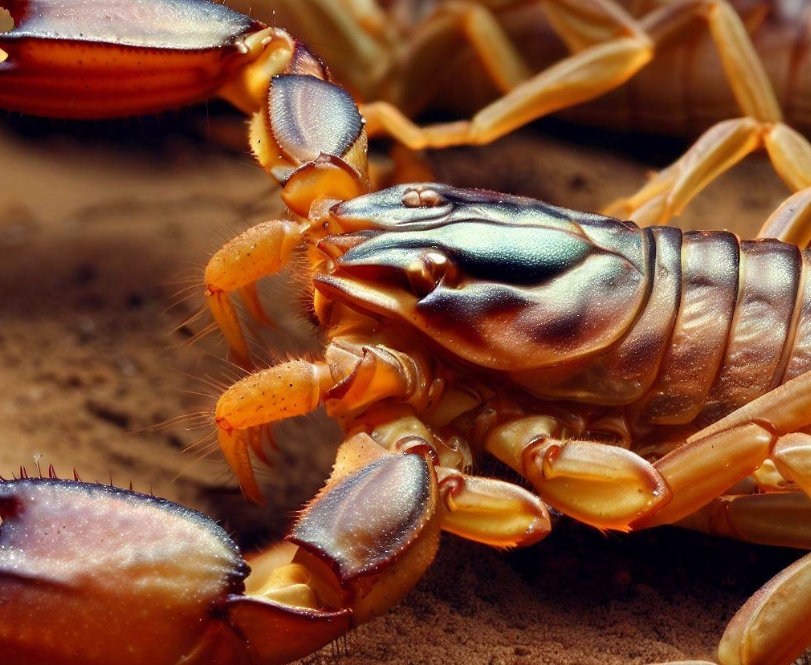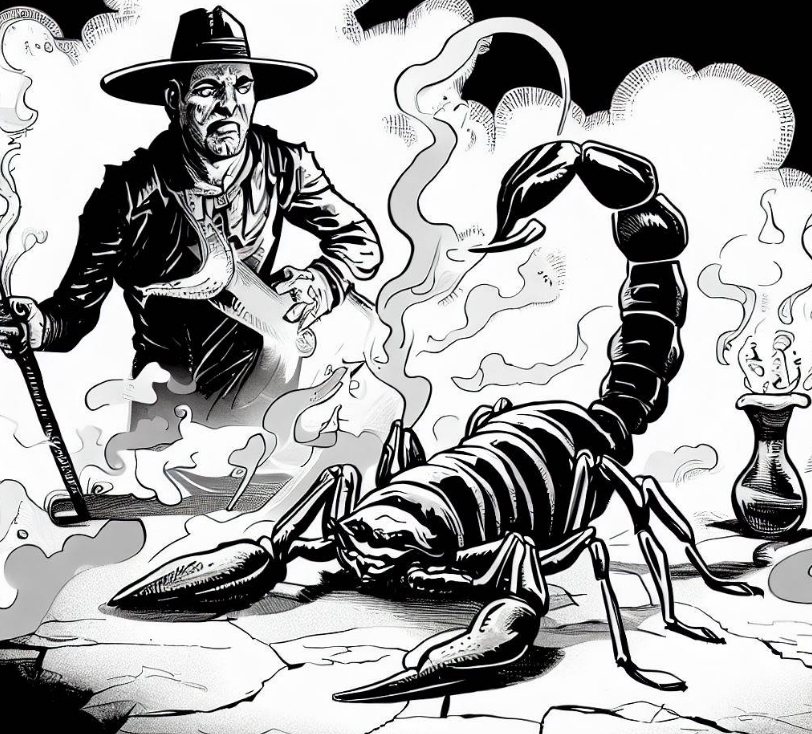When you think of deserts, what comes to mind? Perhaps endless sand dunes, sweltering heat, and the occasional cactus. However, one fascinating creature is also synonymous with these arid landscapes: the desert scorpion. Let’s dive deep into the world of these extraordinary arachnids and explore their unique adaptations, relationships to other creatures, and even their appearances in popular culture.
Are Scorpions Insects or Something Else?
Contents
Contrary to popular belief, scorpions are not insects. They belong to the class Arachnida, which includes spiders, ticks, and mites. As such, they share more similarities with their fellow arachnids than insects. For more information, you can refer to this article on BestPestWorld.com.
Desert Scorpions: Masters of Adaptation
Desert scorpions are specially adapted to thrive in their harsh environments. They have a range of amazing adaptations, which you can learn more about in this in-depth article on BestPestWorld.com. Here are a few highlights:
- Exoskeleton: Scorpions have a thick, waxy exoskeleton that helps them retain water and survive in dry conditions.
- Burrowing: To escape the scorching sun, desert scorpions dig burrows where they can hide during the hottest parts of the day.
- Metabolic efficiency: Scorpions have a slow metabolic rate, which means they can survive on just one meal per month.
- Nocturnal behavior: Desert scorpions are active at night when temperatures are cooler, making it easier for them to hunt and avoid predators.
The Glowing World of Ultra-Violet and Black Scorpions
One of the most intriguing aspects of scorpions is their ability to glow under ultraviolet (UV) light. When exposed to UV light, scorpions produce a greenish-blue fluorescence, making them easier to locate during night-time hunts. You can read more about this fascinating phenomenon in this article on ultra-violet and black scorpions on BestPestWorld.com.
Scorpions and Lobsters: Surprising Relatives
At first glance, scorpions and lobsters seem worlds apart. However, they share a common ancestor and are more closely related than you might think. Both belong to the phylum Arthropoda and share features such as jointed legs and a hard exoskeleton. Learn more about this surprising connection in this article on the relationship between scorpions and lobsters on BestPestWorld.com.
Not Just in the Desert: Yellow-Tailed Scorpion in the UK
While scorpions are typically associated with deserts, some species have adapted to live in other environments. One such example is the yellow-tailed scorpion, which can be found in parts of the United Kingdom. To learn more about this unexpected inhabitant of the UK, check out this article on the yellow-tailed scorpion on BestPestWorld.com.
Crystal Clear: The Transparent Scorpion
Some scorpions have a unique adaptation that sets them apart from their desert-dwelling cousins: transparency. These clear scorpions have a translucent exoskeleton that allows them to blend in with their surroundings, providing excellent camouflage. This is particularly useful for hiding from predators and sneaking up on prey. To learn more about these fascinating creatures, take a look at this article on clear scorpions on BestPestWorld.com.
The Mighty Asian Forest Scorpions
While desert scorpions are fascinating, they’re not the only ones worth discussing. Asian forest scorpions are another intriguing species that have adapted to live in the humid rainforests of Southeast Asia. They are large, dark-colored, and have impressive pincers, making them a popular choice for exotic pet enthusiasts. To learn more about these formidable arachnids, visit this article on Asian forest scorpions on BestPestWorld.com.
Scorpions in Popular Culture: The TV Show “Scorpion”
Scorpions have also made their way into popular culture, with one notable example being the TV show “Scorpion.” This action-packed series, which ran for four seasons, follows a group of geniuses who use their skills to solve high-stakes problems. Though the show doesn’t focus on the animals themselves, its title and themes demonstrate the widespread fascination with these creatures. You can read more about the show in this article about the series “Scorpion” on BestPestWorld.com.
Desert Scorpions: A Step-by-Step Guide
Now that we’ve covered various aspects of desert scorpions, let’s take a closer look at the life of these arachnids, step by step.
- Habitat: Desert scorpions can be found in arid environments worldwide, including the deserts of North America, Africa, and the Middle East.
- Reproduction: Scorpions reproduce through a unique courtship dance, followed by the male depositing a spermatophore, which the female collects to fertilize her eggs.
- Birth: Female scorpions give live birth, carrying their young on their backs until they are old enough to fend for themselves.
- Diet: Scorpions are carnivorous and primarily feed on insects, spiders, and other small arthropods.
- Predators: Scorpions have various predators, including birds, mammals, reptiles, and even other scorpions.
- Venom: While not all scorpions possess venom powerful enough to harm humans, some species have potent venom that can cause severe pain, paralysis, or even death.
Brands That Help You Explore the World of Desert Scorpions
Several brands offer products and services that allow you to learn more about desert scorpions and even experience them up close. Here are a few notable examples:
- BestPestWorld: As seen throughout this article, BestPestWorld.com is an excellent resource for information on various scorpion species, their adaptations, and their roles in the ecosystem.
- ScorpionExpo: ScorpionExpo is a popular event that allows attendees to observe live scorpions, learn from experts, and even purchase scorpion-related products and souvenirs.
- DesertScorpionTours: This tour company offers guided excursions into the desert to observe scorpions in their natural habitat, providing an unforgettable, hands-on experience for adventurers and nature enthusiasts alike.
In conclusion, the world of desert scorpions is fascinating, complex, and full of surprises. These remarkable arachnids have evolved to survive and thrive in some of the harshest environments on Earth. Their adaptations, relationships with other species, and appearances in popular culture demonstrate their incredible resilience and the captivation they hold for humans.
FAQ About Desert Scorpions
To help you better understand the fascinating world of desert scorpions, we’ve compiled a list of frequently asked questions along with their answers.
1. Are desert scorpions dangerous to humans?
While some desert scorpion species possess venom potent enough to cause severe pain, paralysis, or even death in humans, most are not dangerous. However, it’s essential to treat all scorpions with caution and respect, as individual reactions to a sting can vary.
2. How long do desert scorpions live?
The average lifespan of a desert scorpion ranges from 3 to 8 years. Some species, like the Hadrurus arizonensis, can live up to 25 years under optimal conditions.
3. How big can desert scorpions grow?
Desert scorpions can vary greatly in size, with some species measuring less than an inch in length and others reaching up to 8 inches. Generally, larger scorpions tend to have less potent venom, while smaller species may have more potent venom.
4. Can desert scorpions swim?
Scorpions are not known for their swimming abilities, but they can survive being submerged in water for brief periods. Their exoskeletons and spiracles (respiratory openings) help them trap air, allowing them to survive underwater for a short time.
5. How do desert scorpions find their prey?
Desert scorpions rely on their excellent senses of touch and vibration to locate prey. They have specialized sensory organs called pectines on the underside of their abdomen that help them detect vibrations and chemical cues in their environment.
6. Do desert scorpions make good pets?
Some scorpion species can be kept as pets, but they require specialized care and should only be handled by experienced keepers. Additionally, it’s important to research the specific species you’re interested in, as some may be more challenging to care for than others.
7. How do desert scorpions survive extreme heat?
Desert scorpions have several adaptations that help them survive extreme heat. Their thick, waxy exoskeleton helps them retain water, and they often dig burrows to escape the sun’s heat. Additionally, their nocturnal behavior allows them to be active during cooler nighttime temperatures.



